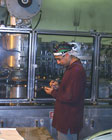
Operators learn to use the SIMS system to track production downtime at S. Martinelli & Co. Source: SIMS.
Rick Gillespie grappled with tracking and analyzing downtime for most of his career as plant manager for S. Martinelli & Co., a bottler of apple cider based in Watsonville, CA. Initially, Gillespie and Ronnie Duarte, his executive assistant, tried to handle the problem with a paper-based system they designed for gathering and analyzing downtime. The paper system started with manually collecting downtime incidents and used reason codes to identify the cause for each production line breakdown.
These paper forms then went through a laborious manual data entry process that culminated in a complex system of spreadsheets for analysis. But Gillespie was having difficulty reconciling production output with recorded downtime, and his limited resources for gathering and analyzing the causes of both mechanical and operational downtime were a further aggravation.
While searching for a better solution, Gillespie saw a demo of the Short Interval Measurement System (SIMS). SIMS President Art Lowery explained to him that SIMS' output-based measurement involves the machine or line operator entering his total bottle production count each hour into a Palm Pilot, which calculates time credit (earned time) based on the Theoretical Maximum Throughput (T-Max). Time that is not earned is considered lost to downtime and must be justified by the operator with a reason code, which could be loaded on the Palm. Lowery explained that it takes about 10 to 15 seconds per hour for each operator to record data on the Palm m100 series.
When Gillespie inquired about start and stop times, Lowery explained that it is more accurate to record information at regular intervals versus when an operator is in crisis mode. This automatically reconciles downtime and output, in addition to accounting for reduced production throughput speed, as well as production stoppages.
Gillespie decided to give a three-month trial subscription a try. During the first month, information concerning the production rate of products and codes for downtime was provided to SIMS for use in customizing the system to fit Martinelli's plant configuration. The next month, Lowery visited the site to conduct training sessions. Each machine operator was introduced to the concepts underlying SIMS' output-based measurements and then given training to record data in the Palm units. Lowery followed the operators onto the floor during all three shifts and continued instruction, stopping at each work station over several hours to ensure that the operators understood the concepts and could operate the Palm. At shift end, each operator brought his Palm to the production office and learned to HotSync data to the PC.
In three days the process was complete, operators on all three shifts were fully trained and the report writing software was installed and running on Duarte's PC. "Entering two dates then one click to run a report sure beats entering all that stuff by hand," says Duarte.
Following installation, the data was reviewed and the report formats were altered to more accurately reflect Martinelli's needs. Additional follow-up with the staff was conducted to ensure the operators were correctly entering codes and shifts as necessary on the Palms.
After the three-month trial, Gillespie was pleased enough with the results to continue with the software. Having used the system for six months now, Gillespie says, "With the SIMS system I find out about problems the next day rather than next week. I feel like I'm finally getting a handle on the problem, thanks to the software."
For more information:
Thomas Lowery, Short Interval Measurement Systems; 888-407-2823; info@gosims.com